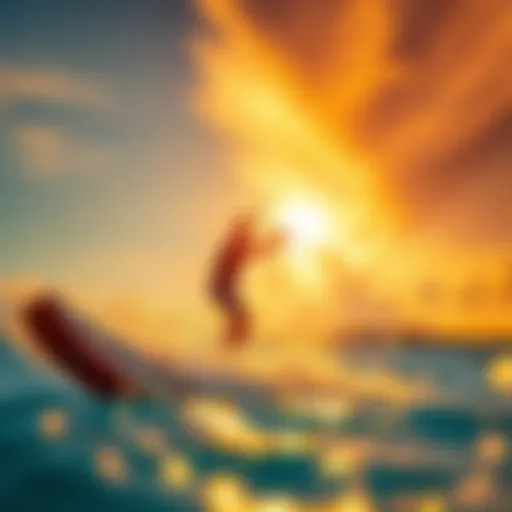Hydrofoil Kit Insights for Kiteboarders
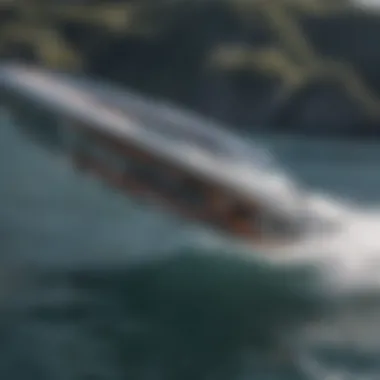

Intro
Kiteboarding is a thrilling sport that brings together the elements of wind, water, and skill, enticing enthusiasts to take to the waves with a sense of adventure. As technology evolves, so do the techniques and equipment used to enhance the kiteboarding experience. One such innovation that has made waves in the kiteboarding community is the hydrofoil kit. This article delves deep into hydrofoils, branching out into the intricacies of design, the various components, and the crucial role they play in boosting performance on the water.
For both novices and seasoned kiteboarders, understanding hydrofoil kits can completely change the way you ride. Unlike traditional setups, these kits lift the board above the water, allowing riders to glide seamlessly and harness the full potential of wind power. However, with this advanced gear comes a host of complexities, challenges, and considerations.
Hydrofoil kits are not just about speed; they transform kiteboarding into an art of finesse and control, marrying power and grace.
As we navigate this guide, expect to find not only essential advice on the selection and maintenance of hydrofoil kits but also insights into safety practices and performance enhancement. Whether you’re looking to slice through the water like a knife or just keen on exploring new horizons in kiteboarding, this guide is tailored for you.
Understanding Hydrofoils
The rise of hydrofoil kits in kiteboarding has quite transformed the experience for enthusiasts and novices alike. This segment will shed light on the fundamental aspects of hydrofoils, explaining their significance in enhancing performance on water and why they have become a popular topic of exploration within the kiteboarding community. Understanding hydrofoils goes beyond just the mechanics; it's about grasping how they can elevate your rides, making them smoother and faster.
Definition and Purpose
A hydrofoil is essentially a lift-generating device that operates underwater, much like an airplane wing. It consists of a wing-like structure attached to a mast, which is anchored to a board. As the foil moves through water at speed, water pressure creates lift, causing the board to rise above the water's surface. This is why experienced riders appreciate hydrofoils—not only does it allow them to skim across water, but it also reduces the amount of drag they encounter.
The primary purpose of hydrofoils in kiteboarding is to enhance speed and efficiency. Unlike traditional boards, which encounter significant resistance from water, hydrofoils glide above, slicing through the waves, resulting in a thrilling ride that is both exhilarating and efficient.
Historical Development
The concept of hydrofoiling isn't a new one; its origins can be traced back to the early 20th century when engineers and tinkerers first experimented with underwater wings. The design gained traction primarily in the realm of sailing, with the first recorded use on sailboats in the 1960s. This idea slowly permeated into other water sports, including kiteboarding, thanks to advances in materials and manufacturing techniques.
Over the years, hydrofoils have evolved. According to various sources, including Wikipedia, improvements in construction materials such as carbon fiber and advanced epoxy resins have revolutionized the field. Now hydrofoils are lighter, stronger, and more responsive, making them accessible to a wider audience, extending from competitive riders to leisure enthusiasts.
How Hydrofoil Kits Work
Understanding the mechanics behind hydrofoil kits can open up a whole new world of possibilities for riders. They function based on two critical principles: lift and drag. When the kiteboarder gains speed, the foil's wings generate lift through the flow of water, which elevates the board above the surface.
Moreover, once airborne, the rider experiences considerably reduced drag compared to riding on traditional boards. This state allows the kiteboarder to ride in lighter winds and over choppy waters with increased stability and control.
For instance, a rider using a hydrofoil kit might find they can capitalize on gusts of wind more effectively—those light puffs that might leave a typical kiteboarder stranded become opportunities for airborne cruising instead. Riders will feel the transformed dynamic, where they can focus more on carving, jumping, or simply enjoying a longer ride without the exhausting drag of the water below.
"When you're riding hydrofoils, you're not just skimming the surface. You're playing with the elements in a whole new way, catching air where you never thought possible."
This understanding of how hydrofoil kits work is fundamental for kiteboarders looking to enhance their skills and extend their riding seasons. Overall, grasping the basics provides a solid foundation to navigate the thrilling waters of hydrofoiling.
Components of a Hydrofoil Kit
Diving into the components of a hydrofoil kit is like peeling back the layers of an onion; each element plays a crucial role in ensuring that your kiteboarding experience is not just thrilling but also efficiently streamlined. A solid understanding of these components can tremendously impact performance and safety on the water.
Foil Wings
The foil wings are arguably the heart and soul of the hydrofoil kit. Think of them as the sails that catch the wind, but instead, they catch the water, lifting you above the surface. The shape, size, and aspect ratio of the wings can dramatically affect your ride. For instance, larger wings are ideal for beginners due to their increased lift and stability, while smaller wings can be optimized for speed and advanced maneuvers.
When considering wing choice, pay attention to the material used. Carbon fiber options are lighter but may come at a premium price. On the other hand, aluminum wings offer durability and cost-effectiveness, appealing to budget-conscious riders. A well-chosen wing not only maximizes speed but also helps maintain control in varied water conditions.
Masts
Next up are the masts, which connect the foil wings to the board. They serve a dual purpose: providing lift when cutting through the water and stability during your ride. Masts can come in different lengths, which can change your experience as a rider. Shorter masts are easier to handle and control, especially in choppy waters, while longer masts offer a smoother glide since they can keep the wings above waves.
Material choice is similarly critical; while aluminum is strong, carbon fiber masts are favored for their lightness and rigidity. Selecting the right mast length and material is essential for balancing performance and comfort. If you’re planning to ride in deeper waters, a longer mast could make all the difference.
Fuselage
The fuselage acts as the backbone of the hydrofoil. This component links the wings and the mast together. A well-constructed fuselage not only ensures proper alignment of the wings, but it also aids in the overall responsiveness of the system. The length of the fuselage can also influence the handling characteristics; a longer fuselage provides better stability, while a shorter one enables more agile maneuvers.
Material selection here, too, is vital. A harder, durable material will ensure that the fuselage can withstand the rigors of rough water and higher speeds. Finding a good balance between weight and durability in this component is another key consideration for optimizing your hydrofoil experience.
Mounting Hardware
Lastly, let’s not forget about the mounting hardware. This comprises the bolts, screws, and other fittings necessary for securely attaching the wings, mast, and fuselage. Quality is paramount here; poor hardware can lead to malfunctions or, worse, accidents on the water.
When purchasing hardware, look for corrosion-resistant materials, especially if you frequently ride in saltwater. It’s also advisable to carry extra screws and bolts, as these can wear down over time or be lost during rides, putting a damper on your adventures.
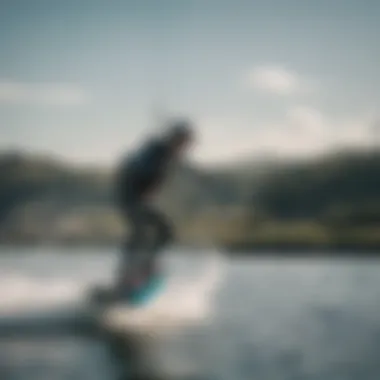

Adopting a meticulous approach to every component can significantly enhance not only your performance but also your safety while kiteboarding. Understanding how each piece works together makes your rides smoother, more efficient, and undeniably more enjoyable. Remember, the devil is in the details, and the right choices can elevate your experience to new heights.
"Invest in quality components and maintenance; they are the keys to unlocking the full potential of hydrofoil kiteboarding."
Selecting a Hydrofoil Kit
Choosing the right hydrofoil kit can shape your entire kiteboarding experience. The decision hinges on various elements that affect performance, safety, and enjoyment on the water. As with anything related to water sports, you want a setup that complements your skill level and environmental conditions. A well-chosen hydrofoil is like a well-fitted wetsuit—it can make or break your session.
Skill Level Considerations
When picking a hydrofoil kit, understanding your skill level is paramount. For novice riders, starting with a kit designed for stability can ease the learning curve. A wider foil wing offers greater lift and helps maintain balance, making it easier to get up and flying. It’s like walking before you run; you want to establish a good foundation before attempting advanced techniques.
Conversely, if you’re experienced, you might prefer a more specialized setup. Advanced riders often favor narrower wings and longer masts that give them agility and speed. You’re trading some stability for precision and responsiveness, ideal for executing those thrilling tricks and maneuvers.
"Choosing the right hydrofoil is not just about skill but about enjoying your ride fully."
Conditions for Use
The conditions where you plan to use the hydrofoil also play a large part in your selection. Do you often hit choppy waters, or do you prefer smooth lakes? If you typically face rough conditions or strong winds, a robust and adjustable hydrofoil kit can help you cut through the waves and maintain control. Stronger materials for construction can withstand the stress better.
For those who enjoy calmer seas, a lighter setup might suffice. Pay attention to wind direction, wave height, and water temperature—these factors impact not only the hydrofoil's performance but also your own. As the saying goes, it’s not just what you ride, but where you ride it too.
Material and Build Quality
The material and build quality of a hydrofoil kit can mean the difference between a stellar performance and a disappointing ride. Common materials include aluminum, carbon fiber, and fiberglass. While aluminum is sturdy and cost-effective, carbon fiber is lightweight and offers superior performance. However, it is also pricier.
A good hydrofoil kit should feature a solid construction, seamlessly connecting wings, masts, and fuselage. Check reviews and testimonials to gauge real-world performance. A flimsy build might lead to a broken kit in the middle of a session—talk about a mood killer!
Ultimately, investing in a high-quality hydrofoil kit pays off, enhancing your performance and ensuring safety on the water. It’s akin to buying a reliable car that takes you places reliably.
By considering skill level, environmental conditions, and material quality, you can select a hydrofoil kit that complements your kiteboarding journey, leading to better experiences on the water.
Benefits of Hydrofoil Kits
A hydrofoil kit can be a game changer for kiteboarders. Not only does it present an innovative aspect to the sport, but it also enhances overall performance in ways that traditional setups simply can’t replicate. From beginners seeking to catch a break to seasoned riders pushing the envelope, understanding these specific benefits is essential for anyone serious about kiteboarding. Let's unravel the advantages of hydrofoil kits by diving deeper into three key areas: increased speed and efficiency, enhanced maneuverability, and minimized water resistance.
Increased Speed and Efficiency
When it comes to speed, hydrofoil kits shine like a diamond under the sun. By lifting the board above the water surface, these kits drastically reduce drag. It's like gliding over a smooth highway instead of trudging through mud. Riders often report feeling as if they’re flying, and this sensation is backed by physics. The lifting force generated by the foil means that less energy is lost to turbulence and drag, allowing riders to harness the wind's power more effectively.
- Lower Drag and Improved Glide: The moment the hydrofoil catches the wind, it effortlessly lifts the rider from the surface, decreasing drag. Hurrah for efficiency!
- Sustainability of Speed: Unlike traditional kiteboarding techniques, which can demand breaks in movement, hydrofoils let riders maintain higher speeds over prolonged periods. Once you're up, it's a continuous ride, with less reliance on consistent gusts.
Enhanced Maneuverability
Maneuverability is another avenue where hydrofoil kits outstrip their conventional counterparts. Imagine skating on ice rather than the rough ground—this sense of fluidity applies to hydrofoiling too. Riders quickly discover that the ability to turn sharply and navigate tight spaces becomes second nature. This new freedom unlocks avenues for creativity in riding styles.
- Responsive Steering: The way a hydrofoil reacts to body shifts is particularly remarkable. A simple lean or shift in weight can instigate lightning-fast turns, allowing for sharp navigation and effortless re-entry into the wind.
- Versatile Riding Styles: Whether zipping in and out of surf or darting between kite lines, hydrofoils adapt well to myriad conditions. From smooth lakes to choppy ocean waves, these kits are better equipped for a variety of environments, giving riders versatile options.
Minimized Water Resistance
Finally, the reduction in water resistance cannot be overstated. One of the major hurdles in traditional kiteboarding is dealing with the choppy waters that can ultimately throw a wrench in the gears of a ride. Hydrofoils combat this challenge with grace. When lifted above the surface, the rider effortlessly glides along, almost cruising at times, rather than struggling against the oncoming forces of the sea.
"Using a hydrofoil kit allows for an experience that feels extraordinarily smooth, as if you're riding a whisper over the waters."
- Optimal Performance in Choppy Waters: Hydrofoils are designed to slice through surface waves, turning potentially turbulent conditions into a smooth sailing experience—perfect for demanding coastal areas.
- Less Energy Expenditure: Riders can engage in longer sessions without the feeling of fatigue that usually comes from dealing with rough waters. As a result, energy can be funneled into performance rather than simply surviving the ride.
In summary, hydrofoil kits offer kiteboarders a host of advantages that can significantly enhance their experience on the water. As riders embrace hydrofoiling and witness these benefits firsthand, it becomes clear that this is not just a trend, but a transformative leap forward for kiteboarding enthusiasts.
Techniques for Riding Hydrofoils
Riding hydrofoils is an art in itself, combining elements of balance, control, and finesse. As kiteboarders venture into this exciting territory, mastering effective techniques becomes crucial not just for enjoyment, but for safety and performance as well. The effort of learning how to ride on a hydrofoil can lead to exhilarating experiences, translating well to all skill levels.
Getting Started
Beginning your journey with a hydrofoil can feel daunting. It’s akin to learning to ride a bike for the first time but with a twist! While traditional kiteboarding provides some familiarity with board control, hydrofoiling adds a new dimension. Here’s how to ease into this transformative experience:
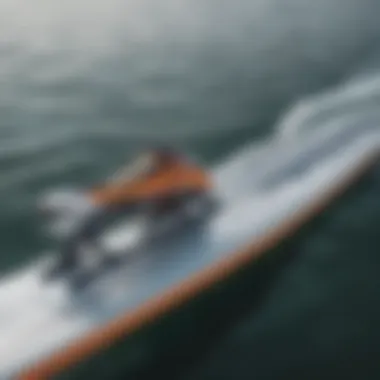

- Choose the Right Setup: Ensure your hydrofoil kit is suitable for your skill level and local conditions. A larger wing surface often offers more lift and stability for beginners.
- Start in Flat Water: Opt for calm waters which will help you get comfortable without the added challenge of waves.
- Practice with the Kite: Get a feel for your kite and practice kite control on your normal board first. This will make the transition smoother once you're ready to foil.
As you’re ready to hit the water, focus on keeping your body centered over the board. Lean back slightly, which encourages lift from the foil and allows for better balance.
Balancing Techniques
Balance is the holy grail of hydrofoiling. A well-timed shift of weight can determine whether you glide gracefully above the surface or take an unexpected dip. Here are some balancing techniques:
- Foot Placement: Position your feet parallel and aligned with the mast. This ensures even weight distribution, crucial for maintaining stability.
- Knee Flexion: Keeping your knees slightly bent will absorb any shocks from the water surface, making it easier to maintain balance.
- Core Engagement: A strong core helps in stabilizing your movements. Engaging your core allows for controlled shifts in weight without losing composure.
- Head Up: Keep your head and eyes facing forward, looking at the horizon. This not only helps in balance but also allows for better awareness of your surroundings.
Over time, you’ll develop a "feel" for the foil. The relationship between pressure under the board and how it responds to your movements is something that becomes instinctive through practice.
Advanced Tricks and Maneuvers
Once you’ve mastered the basics and have the balancing act down, it’s time to push your boundaries. The thrill of hydrofoiling can open up avenues for exciting tricks and maneuvers. Here are some to consider:
- Carving Turns: Initiating a carve is all about shifting your weight onto the back foot, while applying pressure on the front of the board. With practice, this can develop into smooth, flowing turns.
- Jumping: To perform jumps, start with a solid takeoff, using the kite for lift. Aim for a controlled landing by absorbing the impact through your knees, keeping your weight centered.
- Riding Switch: This involves switching your stance mid-ride. It enhances your skill set and increases your adaptability on the water. It takes some courage, but the satisfaction from riding switch is well worth it.
"Commit to the grind. Every mistake is just a stepping stone to that ultimate stunt!"
As you embark, remember that every rider’s journey is unique. Progress may ebb and flow, so patience and relentless practice will be key to mastering the art of hydrofoiling.
With these techniques in your toolkit, the adventure of riding hydrofoils will not only be exhilarating but also immensely rewarding.
Safety Considerations
The allure of hydrofoiling brings with it a distinct set of challenges and risks, necessitating a thorough understanding of safety measures. Kiteboarding, with its blend of speed and proximity to the water, emphasizes the need for additional precautions—especially when hydrofoils are part of the equation. Prioritizing safety not only enhances the enjoyment of the sport but also protects against potential accidents, ensuring that your kiteboarding journeys are both thrilling and risk-managed.
Personal Safety Gear
When engaging in hydrofoiling, your gear acts as your first line of defense. While standard kiteboarding equipment is essential, taking extra steps with protective gear is wise. Consider investing in:
- Impact Vests: These provide cushioning during unexpected tumbles. Falling onto a hydrofoil can lead to injuries, so cushioning your body is beneficial.
- Helmets: Essential for minimizing head injuries in the event of a fall or collision. Opt for one designed specifically for water sports.
- Wetsuits: While they keep you warm, they also protect your skin against abrasions and jellyfish stings. Plus, a wetsuit can help with buoyancy after a fall.
- Leashes: Wearing a leash that connects you to your board prevents it from becoming a hazard in the water. Losing control of your board can create dangerous situations for yourself and others.
Equipping yourself properly is akin to giving yourself a safety net. No one wants a dry run or harsh landing to turn their kiteboarding adventure into a cautionary tale.
Environmental Awareness
Understanding and respecting the natural environment is crucial for any kiteboarder, particularly those venturing into hydrofoiling. Tides, currents, and local wildlife can all impact the safety of your outing. Maintenance of situational awareness helps ensure a positive experience, akin to navigating uncharted waters with caution and respect.
Several factors to consider are:
- Local Wildlife: Pay attention to local restrictions regarding protected marine life. Avoid areas where marine mammals frequent to prevent unintentional disturbances.
- Tides and Currents: Strong currents might catch even the most experienced kiteboarders off guard. Always check the tide schedules and plan your sessions accordingly.
- Weather Conditions: Wind can shift unexpectedly, and sudden storms can arise. Keeping an eye on weather patterns and forecasts minimizes exposure to hazardous conditions.
By staying attuned to the environment, kiteboarders foster a safer experience for themselves and their surroundings, which is a fundamental aspect of responsible riding.
Emergency Procedures
No one ever hopes for an emergency, but being prepared is the hallmark of a seasoned kiteboarder. Establishing a clear plan and familiarizing yourself with emergency procedures before heading out can significantly mitigate risks. Consider these points:
- Know Your Exits: Familiarize yourself with the local coastline and possible exit points in case of emergencies. It’s crucial to know where you can go for help if something goes awry.
- Buddy System: Whenever possible, kiteboard with a partner. Having someone nearby can be a lifesaver if an injury occurs.
- Whistles and Signaling Devices: Carry a whistle or a signaling device that can be easily accessed in case of distress. Using bright-colored equipment can also help in spotting someone in need.
- Basic First Aid Knowledge: Having a grasp of first aid can make all the difference in an emergency. Consider taking a first aid and CPR course, equipping yourself with the know-how to provide assistance if required.
Preparedness turns panic into action.
In the end, each component of safety measures—from gear selection to environmental respect—feeds into the overall experience of hydrofoiling. It’s about enjoying the ride while preparing for the unforeseen. With proper care, your adventure on the water can be as exhilarating as it should be safe.
Maintenance and Care for Hydrofoil Kits
Keeping your hydrofoil kit in top shape is essential not just for performance but also for safety. Regular maintenance can extend the lifespan of your equipment and ensure that you're getting the most out of your kiteboarding experience. Just like a car needs tune-ups, so too does your hydrofoil. Neglecting it might cost you in the long run, both in repairs and in the enjoyment you get from riding.
Regular Inspections
Conducting regular inspections of your hydrofoil kit is paramount. This helps catch any potential issues before they escalate into major problems. Pay special attention to the fuselage, mast, and wings for any signs of wear, cracks, or corrosion. Here are some key points to consider during your inspections:
- Check Connections: Ensure that all connections between the mast and fuselage are secure. Loose connections can lead to instability when riding.
- Examine the Foil Wings: Look for chips or dents that could affect the aerodynamic efficiency. Even small damages can make a noticeable difference in performance.
- Inspect Hardware: Look at screws, bolts, and any mounting hardware. Rust or wear can lead to failures, which can be dangerous.
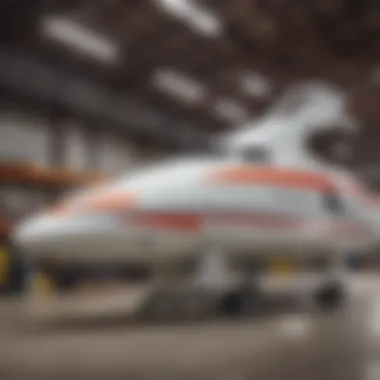

Adding a habit of inspection every time you plan to use your hydrofoil kit can do wonders in catching issues early. It doesn’t have to be a drawn-out process—just a quick glance can often do the trick.
Cleaning and Storage
Keeping your hydrofoil clean not only enhances its appearance but also its performance. After a day on the water, it's essential to rinse down your equipment with fresh water to remove salt, dirt, and sand that may have accumulated. Here’s a simple cleaning routine:
- Rinse with Fresh Water: After each use, ensure you spray the entire kit down with fresh water. This prevents salt from corroding the metal parts.
- Dry Thoroughly: It’s vital to dry the components completely before storing them. This helps in preventing rust and mildew build-up, especially in the joints and mounting areas.
- Store in a Cool, Dry Place: Humidity can be detrimental. When not in use, store your foil kit in a dry, cool location, preferably in a padded bag to prevent scratches and impacts.
Remember, a little maintenance goes a long way. Taking time to care for your kit will pay dividends in performance and safety down the line.
Repair and Replacement Parts
Over time, every piece of kit will undergo wear, and hydrofoils are no different. Knowing what parts may need replacing and when can keep you riding without interruptions. Some common parts to consider include:
- Foil Wings: They can experience wear from impacts and usage; It’s advisable to keep an extra wing or two for emergencies.
- Masts: Watch for signs of bending or cracking, as these parts bear significant forces while on the water.
- Fuselage and Mounting Hardware: These can corrode over time, prompting the need for replacements.
Maintaining an inventory of frequently used spare parts can save you from long downtimes when your kit needs attention. Familiarize yourself with the replacement process as well. Being able to swap out bits and bobs can turn a frustrating experience into a quick fix.
By following these maintenance and care guidelines, you’ll not only keep your hydrofoil kit performing well but also ensure that every kiteboarding session is safe and enjoyable.
Hydrofoil Kits and Travel
When kiteboarders think about traveling, having a hydrofoil kit might not always be the first thought that crosses their minds. However, the integration of hydrofoil kits into the travel lifestyle is crucial. These kits not only amplify the fun associated with kiteboarding but also introduce unique experiences across different locales. With the right kit in tow, the world becomes your playground, and the open water can feel dramatically different whether you're in the Caribbean or a small lake back home.
Transporting Hydrofoil Kits
Transporting hydrofoil kits requires careful planning. They can be bulky and delicate, so ensuring their safety during transit is crucial. There are a few strategies to make this process smoother:
- Use a Protective Bag: A dedicated travel bag designed for hydrofoil kits is a must. Look for bags padded with impact-resistant cushioning. This helps protect the wings and mast from accidental bumps and scrapes.
- Dismantling for Space: Break down the kit when packing. Remove the wings, mast, and fuselage. This not only makes it easier to pack but prevents twisting and stress on the components that can occur in transit.
- Weight Considerations: Keep an eye on the weight limits imposed by airlines, buses, or trains. Sometimes all the excitement to travel can lead to over-packing. Every extra pound can raise costs or lead to complications at check-in.
Tip: Check with the transport service you plan to use for specific regulations regarding sports gear. Each service can have different policies, and being prepared saves last-minute hassle.
Best Locations for Hydrofoiling
Finding the right spot for hydrofoiling can make or break the experience. It’s essential to choose areas known for favorable conditions such as consistent wind patterns, flat and clear waters, and minimal obstacles.
Some prime spots to consider include:
- The Outer Banks, North Carolina: This stretch of coastline is famous among water sports enthusiasts. The shallow waters create an ideal environment for hydrofoiling, offering beautiful scenery along with great conditions.
- Lake Havasu, Arizona: Known for its clear waters and consistent winds, this lake is a favorite for many kiteboarders. The warm weather year-round makes it particularly appealing for travelers.
- Tarifa, Spain: Often dubbed as the kiteboarding capital of Europe, Tarifa has a strong wind conditions and an energetic vibe. Adding hydrofoil sessions to your travel here is a given.
- Cape Town, South Africa: With its stunning backdrop and reliable winds, Cape Town is a must-visit destination for kiteboarders looking to combine health, adventure, and visual feasts.
Navigating through new places with your hydrofoil kit can enhance not just the sport but also your travels. By meticulously packing and choosing your locations wisely, you will set yourself up for memorable sessions that can’t help but broaden your horizons.
The Future of Hydrofoiling in Kiteboarding
The world of kiteboarding is like a marvelous dance with the wind and water. It’s constantly sweeping towards innovation, and hydrofoiling is at the forefront of this evolution. As the sport grows more accessible, understanding the trajectory of hydrofoiling becomes crucial for kiteboarders, whether they’re just starting or are seasoned pros. The future of hydrofoiling holds promise not only in performance but also in technology and community building.
Innovations in Design
Innovation in hydrofoil design is reshaping how riders experience the water. Engineers and designers are pouring their creativity into lighter, stronger materials, which translate to improved performance. For instance, advancements in carbon fiber technology are enabling manufacturers to create foils that are not only durable but also incredibly lightweight.
- Modular Design: Many brands are now focusing on modular designs, which allow riders to swap wings and masts easily, catering to different conditions and skill levels. This flexibility can dramatically enhance the riding experience.
- Shaping Technology: The shape of the hydrofoil plays a substantial role in its efficiency and maneuverability. Designers are experimenting with varied wing shapes, angles, and sizes to optimize lift while reducing drag.
- User-Centric Features: Features such as adjustable wings and user-friendly mounting systems are emerging. They cater directly to the rider's preferences, making the whole setup process smoother and more intuitive.
These innovations offer kiteboarders the chance to explore a wider variety of conditions, pushing the boundaries of where and how hydrofoils can be used. As these designs continue to evolve, kiteboarders can expect exhilarating new experiences on the water.
Growing Popularity
The surge in popularity of hydrofoiling cannot be ignored. Riding a hydrofoil allows kiteboarders to glide above the water, creating an experience akin to flying. With the sport gaining traction across various demographics, it’s not just the seasoned veterans who are drawn in; newcomers are increasingly curious about picking up hydrofoiling as well.
- Community and Events: More kiteboarding events and competitions are incorporating hydrofoiling, fostering a community that shares tips, tricks, and experiences. Social platforms like Reddit and Facebook have groups dedicated to hydrofoiling, where enthusiasts connect and learn from each other.
- Evolving Equipment: As awareness of hydrofoiling grows, so does the diversity of available products. Multiple brands are entering the market, each offering a range of kits that cater to various skill levels. This blossoming variety means affordability and accessibility are on the rise, making it easier for more people to jump in.
- Media Influence: The growth in digital content focusing on hydrofoiling is another significant factor. From YouTube tutorials to Instagram reels showing impressive tricks, visual media helps demystify the sport and attracts newcomers.
Finale
The conclusion of this guide serves not only as a capstone but also reinforces the importance of understanding hydrofoil kits in the context of kiteboarding. This section synthesizes key elements discussed throughout the article, ensuring that readers grasp the multifaceted benefits and considerations associated with hydrofoiling.
Recap of Key Points
To recap, hydrofoils have revolutionized the kiteboarding scene by enhancing speed, improving maneuverability, and significantly reducing water resistance, allowing riders to glide smoothly above the surface. The essential components of a hydrofoil kit, including wings, masts, and fuselages, contribute towards creating an effective and dynamic riding experience. Moreover, we discussed the importance of selecting the right kit based on one’s skill level and the conditions in which one plans to ride. This consideration is critical for safety and performance. Regular maintenance and understanding the proper techniques for riding hydrofoils play pivotal roles in maximizing one’s enjoyment on the water.
"Hydrofoiling isn’t just about a thrill; it's about diving into an entirely new fluid dynamics experience that elevates traditional kiteboarding."
Encouragement to Explore
As we wrap up, this guide serves as an encouragement for both neophytes and seasoned kiteboarders alike to delve further into the world of hydrofoiling. With its ongoing innovations and the growing community surrounding it, every ride offers an opportunity for exploration and growth. Don't hesitate to experiment with different setups or practice advanced maneuvers. The thrill of hydrofoiling is waiting just beyond the horizon. Whether it's on the placid lakes or the choppy seas, your next adventure in kiteboarding could be elevated by embracing the hydrofoil kit. So, harness that wind and let your passion for the water guide you!







